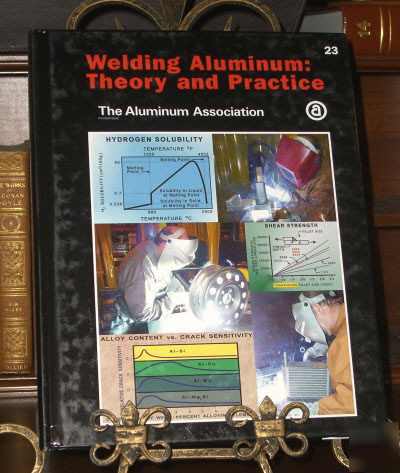WELDING ALUMINUM: THEORY AND PRACTICE__________
The fourth edition of this classic aluminum welding textbook has been edited, revised and expanded; it has a number of new chapters and many updates which reflect technological developments in the welding of aluminum alloys.
It covers all operations from welding design, metal preparation, Gas Metal Arc Welding, Gas Tungsten Arc Welding, Electron Beam Welding, Laser Beam Welding, Resistance Welding and many other welding processes, through weld performance, welding codes and standards for aluminum welding and control of aluminum weld quality.
Review by The Aluminum Association:
Welding Aluminum: Theory and Practice has traditionally been the go to publication for information on joining aluminum. While it is not comprehensive in every aspect of joining, it gathers in one place the key topics. Perhaps the main accomplishment of this publication is its ability to bring together the metallurgical aspects of welding processes on a reasonably theoretical level with the practical elements of actually carrying out those processes in the real world. The book has been edited, revised, and expanded by the Aluminum Association's Technical Committee on Welding and Joining. So, with the recent release of the Fourth Edition of this publication, it is timely to take a closer look at what it contains.
The first three chapters of the book focus on the metallurgical basis for welding aluminum. This is necessary because, as the book points out, contrary to popular belief, aluminum alloys are not difficult to weld. However, aluminum alloys have unique characteristics that must be considered for successful joining. This statement is in reference primarily to differences in welding between steel and aluminum, and the initial chapters help the reader to understand the source of some of these differences. Included are discussions of aluminum's solubility for hydrogen, the presence and effects of the surface oxide, higher thermal conductivity and coefficient of thermal expansion, and greater solidification shrinkage.
With this excellent background, the foundation is laid for the discussion of the various joining methods used for aluminum. Two initial chapters discuss metal preparation and additional operations related to welding, noting that good preparation is necessary to achieve good welds. These are followed by chapters devoted to specific processes. The focus here is squarely on the inert gas welding processes, namely gas tungsten arc welding (GTAW, or sometimes called TIG welding) and gas metal arc welding (GMAW, or sometimes called MIG, welding), as they are the most commonly used. Comparisons between the two processes as well as process specifics are provided. The information provided is very practical, with discussion of equipment, welding techniques, joint geometries, and procedures. The procedures provided for groove, fillet, lap, edge, and corner welding are a set of conditions that give the desired penetration and bead shape at optimum welding speed without causing weld defects or requiring that the welder be excessively skillful. Other fusion welding processes are discussed as well, including electron beam, laser, plasma arc, and many more. The depth of information here is less than for GTAW and GMAW, being more descriptive in nature and probably most useful for awareness of processes that may be applicable for special cases.
The next series of chapters address the issues of weld design, performance, and quality assurance. These again refer primarily to the inert gas welding processes. The design for welding section discusses process and design considerations together, showing how joint design and welding process interact through an example-based approach. Weld quality control reviews both non-destructive and destructive techniques, and is supported by some further metallurgically oriented discussion of weld performance.
With the goal of providing comprehensive coverage of joining aluminum, this book also covers a number of other processes, again primarily at a descriptive level. Sections are provided on resistance welding, solid state welding (including a brief description of the emerging friction stir welding method), brazing, soldering, adhesive bonding, and mechanical fastening. In addition, joining aluminum to other metals is briefly covered. While there are certainly more in-depth publications available in each of these areas (some of them from the Aluminum Association), the descriptions provided here are useful to gain an overall picture.
Health and safety considerations are briefly discussed with reference to publications available from the American Welding Society (AWS) and the Aluminum Association. Likewise, a chapter entitled Codes and Standards for Aluminum Welding provides a table of contents of sorts for these codes and standards, with the primary sources for them being identified as AWS and the American Society of Mechanical Engineers (ASME), particularly the Boiler and Pressure Vessel Codes in the case of the latter organization. (Note that some discussion of application of standards for aluminum welding for structural applications is contained in the book Aluminum Structures: A Guide to their Specification and Design by Kissell and Ferry.) The final section of this book provides additional information sources to supplement that provided in each of the chapters."
* PUBLISHER: Aluminum Association
* NUMBER OF PAGES: Approx 200
* Brand new book. Glossy finish on cover is scuffed, cover has tiny corner bumps. Pages are pristine.
Please visit our store by clicking on logo below - items are categorized so you can shop in your area of interest.
